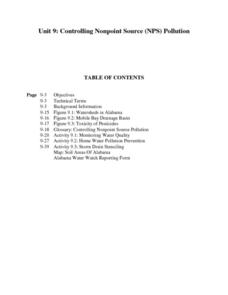Curated OER
Group Foraging
Young scholars explore co-operation by researching ocean life. In this fish science lesson, students identify many vocabulary terms associated with oceanography and discuss what group foraging means among fish. Young scholars utilize...
Curated OER
Optimal Foraging
Students participate in a foraging activity that demonstrates environmental conditions playing an important role in determining the optimal foraging behavior of a particular organism.
ARKive
Biodiversity and Evolution – Darwin’s Finches
Teens experience natural selection firsthand (or first beak) in an activity that has them act as finches foraging for food. Using different household items to act as different beak styles, your little finches will collect as much food...
Curated OER
Measuring Feeding Trays
Students measure the remains of a feeding tray after its left overnight near the Jordanelle Reservoir. They test animal foraging behaviors. Students document their findings and then share their findings with the classroom.
Curated OER
Insects!
Students explore the diet of insects. In this "insects" biology lesson, students take a nature walk and collect various natural materials they think may be eaten by insects. Students sort and classify these materials into three diet...
Curated OER
THE FABLE OF THE FAINTING GOATS
Students practice telling time while reading a story about a fainting goat. They write their own story about a fainting goat. Students write letters to the International Fainting Goat Association, asking for more information about...
Curated OER
Learning By Bees
High schoolers investigate learning by bees as related to vision and foraging behavior. The experiment is done outdoors where bees are foraging for food. They make their observations and record their data which is shared with the class.
Smithsonian Institution
Who's in Camp?
Pupils complete readings, a group activity using cards, and a writing activity to better understand people's lives during the American Revolution. The resource emphasizes people such as the militiamen, women, officers, and children,...
Curated OER
Forest Food Webs
Students consider the interdependency of life in a temperate forest by studying selected organisms from an Asian temperate forest and creating a food web.
Curated OER
Controlling Nonpoint Source Pollution
Learners examine factors affecting water quality. They test water in a local body of water to determine its quality. They collect data and continue monitoring the water monthly. They assess water quality in the home and on the farm.
Curated OER
Science: Bees: An Interdisciplinary Approach
Students investigate the world of bees and describe their characteristics. by identifying the bees' parts, they demonstrate how these parts function. In the lab, students dissect bees and view the various parts under microscopes. ...
Curated OER
Penguins Nesting Know-How
Students maintain a field journal as they follow penguin parents raising their chicks during the breeding season. They formulate testable questions. Students reflect on animal behavior in the field related to survival and chick rearing.
Curated OER
Oklahoma Wheat on the World Market
Sixth graders explore profit and loss in the wheat trading market. In this sixth grade mathematics lesson/social studies lesson, 6th graders play a “Wheat Market Trading Game” in order to investigate the concept of supply and demand and...
Curated OER
Reflect on this Mote of Dust
Students explore space science by analyzing a speech by Carl Sagan. In this cosmos instructional activity, students view an online video of a speck of a "pale blue dot" in the distance of space which turns out to be Earth. Students write...
Curated OER
Hopper Hunt: IPM Decision-making in Alfalfa
Learners describe migrations and life cycle pattersn of a key alfalfa pest, the Porato Leafhopper. They define the Economic Inquiry Level and Economic Threshold. Students evaluate data in relation to profit as it applies to IPM. They...
Curated OER
HAPPY SOIL, SAD SOIL
Learners will be able to identify the characteristics of healthy soil and unhealthy soil.Take the class outside to an area of thick grass near trees, if available. Compare the
clothes people wear to the thin cover. Discuss the reasons...
Curated OER
THE FARMER CARES FOR THE LAND
Young scholars will identify cause and effect relationships in issues relating to Agriculture and the environment.Ask students to describe what farmers do. Then ask young scholars to define the word "environmentalist." Ask students if...
Curated OER
Impact of Exotic Species on Lake Ecology
Students examine the effect of foreign species on various habitats. In groups, they identify the population dynamics of the zebra mussel. They calculate averages and graph data from Seneca Lake in New York. They develop hypothesis...
Curated OER
Comparing Two Turtles
Students compare and contrast the various observable features of two different turtles. in groups, they complete a visual analysis of the sea turtle and tortoise. Using their observations, they complete Venn Diagram of the observable...
Curated OER
Soybean Science
Fourth graders explore food science by participating in a cooking activity. In this soybean oil lesson, 4th graders listen as the teacher gives them a background on soybeans and their use by humans today. Students grind soybeans and...
Curated OER
Spring Collecting and Identifying Bumble Bees
Students collect bumble bees in the field, record data, pin and label specimens, answer conclusion questions, and send specimens to research leaders for verification. They improve their ability to work in research teams. Students...
Curated OER
Communication in Bees
Eighth graders identify and interpret a scientific investigation and a hypothesis through experimentation and testing a hypothesis. They identify what scientists hypothesized about the communication of stingless bees. Finally, 8th...
Curated OER
Ping Pong Vocabulary
Students estimate the size of a sea turtle nest, or clutch, that contains about 120 eggs. They decide what type of container that they are familiar with that could hold a complete nest or clutch. Finally, students calculate the volume...
Curated OER
Loggerhead Nest Management Program
Students identify the sea turtle management documentary and complete an activity for each slide. They plot the location of nests laid on the island they patrol and discuss their rationale for management decisions. Finally, students...

























